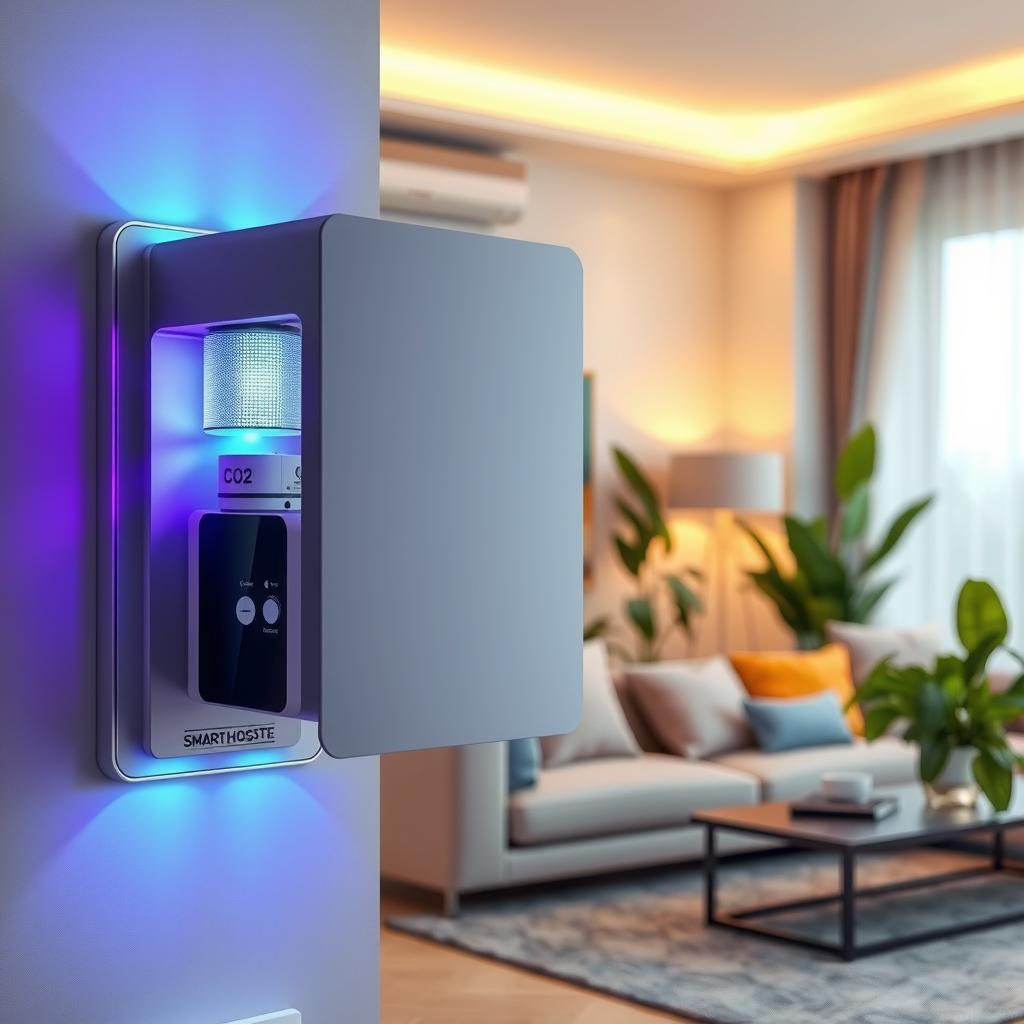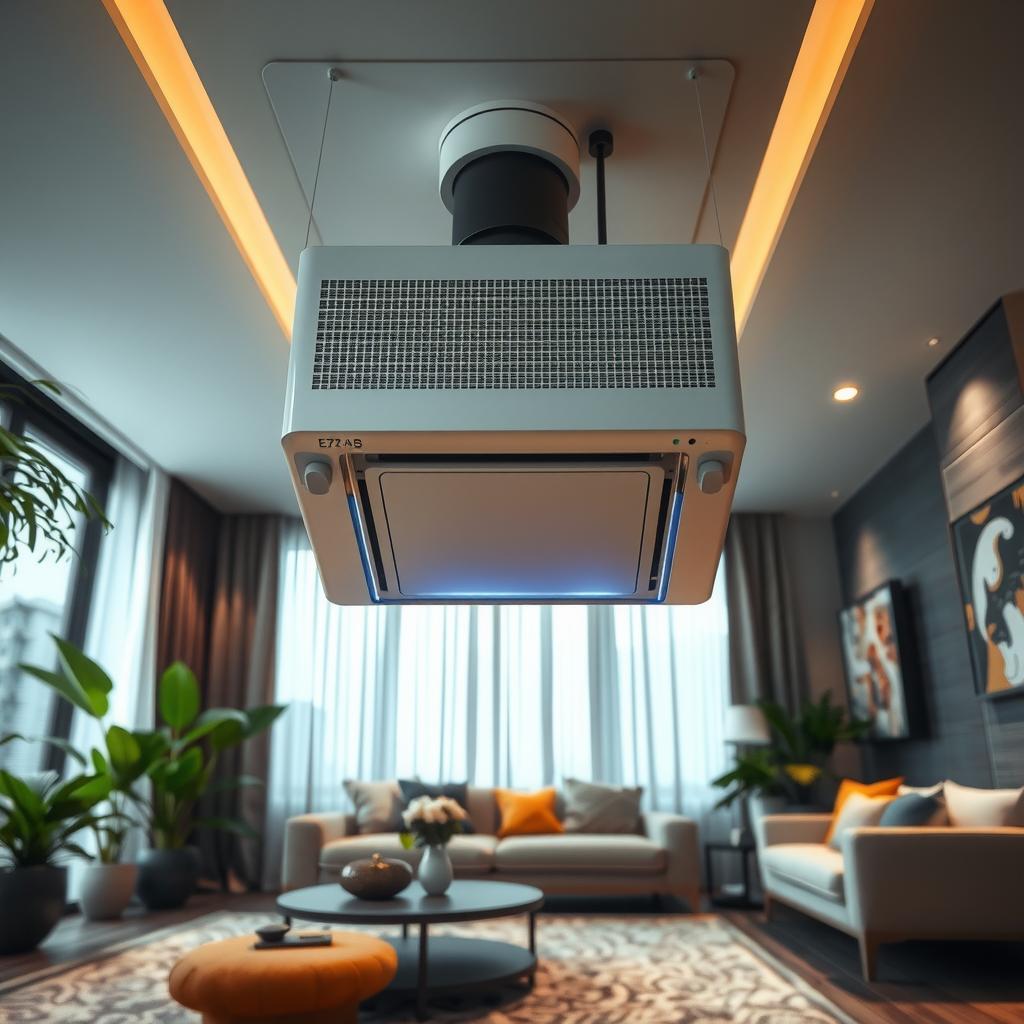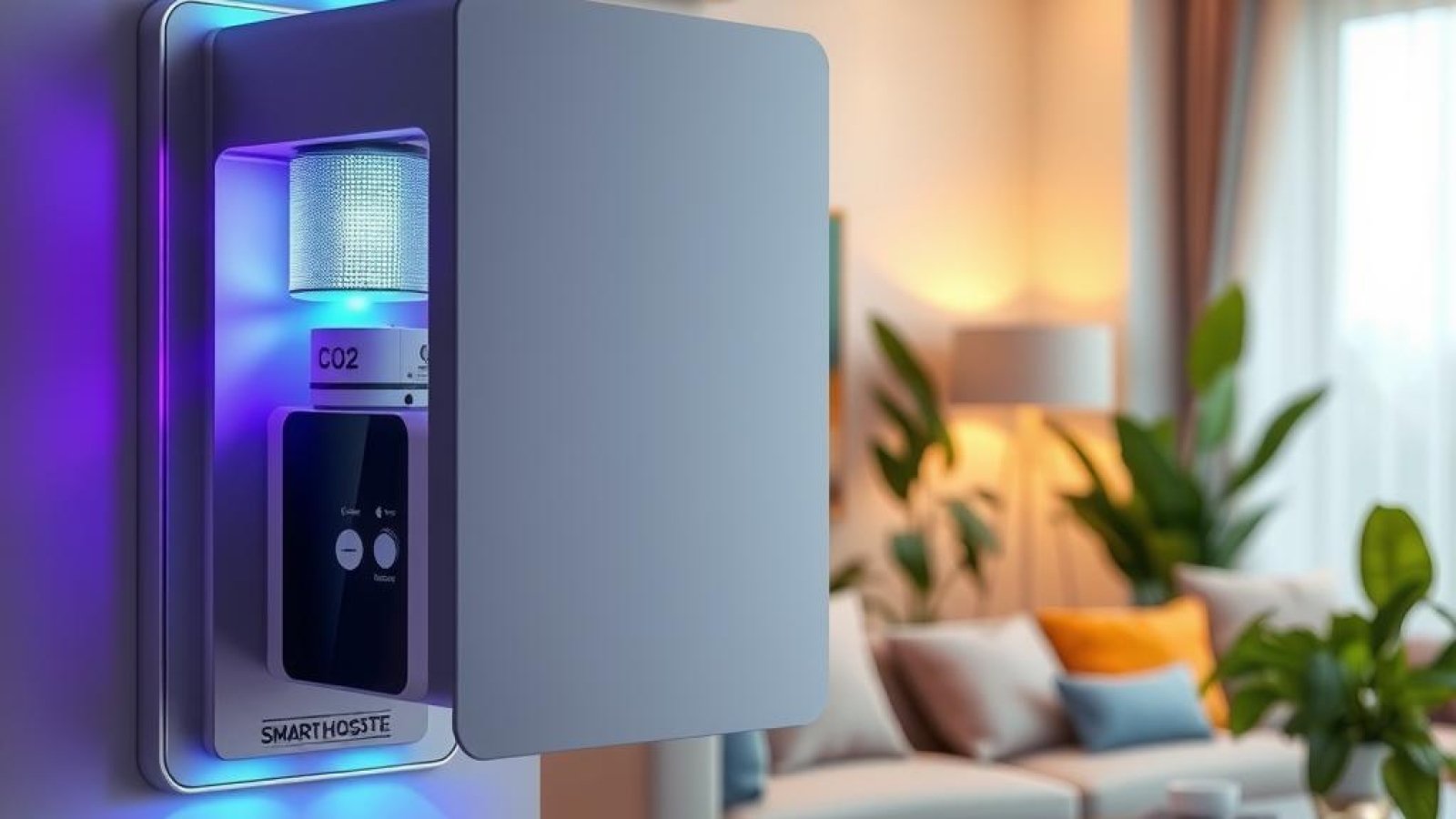In an age where indoor air quality significantly impacts overall health and well-being, the rise of smart ventilation systems has emerged as a crucial solution to a common problem: poor air circulation due to elevated CO2 levels. Many individuals may not realize that stagnant indoor air can lead to discomfort, decreased productivity, and even long-term health issues. This alarming reality highlights the necessity for innovative ventilation solutions that go beyond traditional methods. Enter smart ventilation, a technology designed to monitor and respond dynamically to environmental conditions within living spaces.
The core value of integrating smart ventilation systems lies in their ability to optimize indoor environments by effectively managing airflow based on real-time data related to CO2 levels. By leveraging advanced sensors and automation technologies, these intelligent systems ensure optimal air quality while simultaneously enhancing energy efficiency. As homes and offices increasingly prioritize sustainability in their design choices, incorporating smart ventilation becomes not just advantageous but essential for achieving comprehensive environmental monitoring.
Imagine walking into a room equipped with such sophisticated technology; as you enter, it adapts instantly—sensing your presence and adjusting its operation accordingly. This seamless interaction creates a comfortable atmosphere while minimizing unnecessary energy consumption associated with conventional venting practices. With rising concerns about climate change and resource management, embracing sustainable design through strategies like smart ventilation represents both an ethical commitment and practical investment.
This blog post will delve deeper into how implementing smart ventilation can revolutionize indoor environments by addressing CO2 fluctuations head-on while promoting cleaner air circulation tailored specifically for modern lifestyles. Readers will discover how this forward-thinking approach enhances not only personal comfort but also aligns with broader goals of sustainability—ultimately leading towards healthier living spaces for everyone involved.

Key points:
-
Real-Time CO2 Monitoring: Smart ventilation systems utilize advanced sensors to monitor indoor CO2 levels in real-time, allowing for immediate adjustments to airflow based on current air quality conditions. This proactive approach not only enhances indoor air quality but also addresses the risks associated with elevated carbon dioxide concentrations, such as fatigue and reduced cognitive function.
-
Energy Efficiency through Adaptive Airflow: By integrating automation technologies, smart ventilation solutions optimize energy consumption by adjusting heating and cooling based on occupancy patterns. When spaces are unoccupied, these systems minimize energy usage while maintaining adequate air circulation, ensuring that comfort is never compromised even during significant reductions in energy expenditure.
-
Sustainable Design Integration: The implementation of smart ventilation aligns with principles of sustainable design by actively reducing the environmental impact of indoor environments. Enhanced air circulation removes pollutants effectively without excessive energy consumption, helping users achieve healthier living spaces while significantly lowering their carbon footprint in a world increasingly focused on sustainability.

Understanding Indoor Air Quality: The Impact of CO2 Levels
The Importance of Monitoring CO2 Levels in Indoor Spaces
Elevated levels of carbon dioxide (CO2) in indoor environments can significantly impact both health and productivity. Research indicates that the concentration of CO2 is an essential indicator of indoor air quality, with levels above 1000 parts per million (ppm) often linked to diminished cognitive function and increased discomfort among occupants. As individuals spend a substantial amount of their time indoors—over 90% according to some studies—the importance of maintaining optimal indoor air quality becomes paramount. One effective solution for managing these elevated CO2 levels is the implementation of smart ventilation systems that intelligently adjust airflow based on real-time data from environmental monitoring sensors, ensuring adequate fresh air circulation. These advanced technologies not only enhance occupant comfort but also contribute to better energy efficiency by regulating the heating, cooling, and ventilation requirements according to occupancy patterns.
Health Implications Linked to High CO2 Concentrations
High concentrations of CO2 can lead to various health issues ranging from headaches and fatigue to more severe respiratory problems over prolonged exposure periods. Studies have shown that as indoor CO2 levels rise beyond acceptable thresholds, cognitive performance declines significantly; this includes reduced decision-making abilities and impaired attention spans. For instance, a study published in Environmental Health Perspectives found that participants exposed to higher levels exhibited slower reaction times and decreased task performance efficiency. To combat these adverse effects, integrating smart ventilation solutions into building designs offers a proactive approach by continuously monitoring air quality metrics like temperature and humidity alongside CO2 concentrations. This ensures consistent delivery of fresh outdoor air while minimizing energy use—a crucial consideration in sustainable design practices.
Enhancing Workplace Productivity through Improved Air Circulation
In workplace settings where high productivity is crucial, maintaining an optimal indoor atmosphere directly correlates with employee output and satisfaction rates. Elevated CO2 levels can create an oppressive environment leading employees to experience lethargy or difficulty concentrating on tasks at hand. Implementing effective ventilation solutions, such as automated window operations or mechanical ventilation systems equipped with smart controls allows building managers not only to regulate air quality efficiently but also optimize energy consumption during peak usage hours when fresh airflow is critical most needed for enhancing focus among workers engaged in complex tasks requiring mental acuity.
Sustainable Design Practices Incorporating Smart Ventilation
The integration of smart ventilation technology within new construction projects represents a forward-thinking approach toward sustainability while addressing the pressing issue posed by rising urban populations leading inevitably towards increased pollution affecting overall indoor air quality._ Architects are now considering how best they can incorporate elements such as passive strategies—like orienting buildings towards prevailing winds—and active systems capable adjusting themselves dynamically based upon live feedback gathered via sensor networks aiding continuous improvement efforts around environmental monitoring initiatives contributing ultimately towards healthier living spaces characterized by lower incidences related chronic illnesses associated poor-quality breathing spaces thus promoting wellness across communities relying heavily upon well-designed infrastructures built around principles grounded firmly within ecological frameworks prioritizing human-centered approaches throughout development cycles fostering resilience against future challenges brought forth climate change phenomena impacting societies globally today more than ever before!
By focusing on these key elements surrounding heightened awareness regarding detrimental effects stemming from unmanaged high atmospheric contaminants including excess carbon dioxide emissions we create pathways toward establishing environments conducive thriving lifestyles benefiting everyone involved!
The Technology Behind Smart Ventilation Systems
Harnessing Real-Time Data for Enhanced Indoor Air Quality
Smart ventilation systems are revolutionizing how indoor environments manage airflow, primarily through their ability to monitor and adjust based on real-time CO2 levels. These innovative solutions leverage advanced environmental monitoring technology that continuously tracks air quality parameters, allowing for dynamic adjustments in airflow. By integrating sensors that measure carbon dioxide concentrations, smart ventilation systems ensure optimal air circulation throughout a building. This responsiveness not only enhances indoor air quality but also contributes significantly to energy efficiency by reducing unnecessary heating or cooling.
One of the primary advantages of smart ventilation is its capability to maintain comfortable living and working conditions while minimizing energy consumption. Traditional ventilation methods often operate on fixed schedules regardless of occupancy or actual air quality needs, leading to wasted energy when spaces are unoccupied or when outdoor conditions permit natural airflow. In contrast, smart systems intelligently regulate the amount of fresh air introduced into a space based on current CO2 data. For instance, during peak occupancy times in an office setting where CO2 levels rise rapidly due to human activity, these systems can increase ventilator output appropriately and thus prevent discomfort associated with stale air.
Moreover, the integration of such technologies reflects broader trends towards sustainable design within building management practices. As organizations strive for greener operations and reduced carbon footprints, employing effective ventilation solutions like smart systems becomes essential. They not only help meet environmental regulations but also enhance occupant well-being—a critical aspect as people become increasingly aware of how their surroundings impact health and productivity.
In addition to improving comfort and sustainability measures in buildings, smart ventilation has implications beyond mere convenience; it plays a crucial role in public health strategies aimed at combating airborne pathogens spread through inadequate airflow. A system capable of adjusting itself according to real-time measurements can help mitigate risks associated with poor indoor environments while supporting overall wellness initiatives.
In summary, smart ventilation exemplifies cutting-edge technology’s potential by enabling more efficient use of resources while addressing fundamental needs related to air circulation, indoor climate control, and environmental responsibility. As urban populations continue growing—exacerbating challenges related to pollution—it becomes imperative that builders adopt intelligent approaches such as these that promise enhanced performance without compromising our planet’s future.
The Importance of Smart Ventilation in Sustainable Living
Enhancing Indoor Air Quality While Minimizing Environmental Impact
Smart ventilation systems are emerging as a cornerstone of sustainable living, offering innovative solutions that not only optimize indoor air quality but also significantly reduce the carbon footprint associated with traditional ventilation methods. These advanced systems actively monitor CO2 levels and adjust airflow accordingly, ensuring that indoor environments remain comfortable while minimizing energy consumption. By enhancing air circulation through intelligent design, smart ventilation contributes to improved health outcomes for occupants by reducing exposure to pollutants and allergens commonly found indoors. Moreover, as buildings account for a substantial percentage of global energy use, integrating smart ventilation technologies stands out as an effective strategy for promoting energy efficiency. As reported by various studies, optimizing HVAC operations through these sophisticated systems can lead to up to 50% reduction in overall energy costs while maintaining superior comfort levels.
Technology Meets Sustainability
Innovations Driving the Future of Energy-Efficient Design
The integration of smart technologies into building designs has revolutionized how we approach environmental sustainability. Smart ventilation is at the forefront of this movement; it leverages IoT (Internet of Things) sensors and automated controls to ensure optimal performance without excessive resource consumption. For instance, these systems can detect changes in occupancy or external weather conditions and automatically adjust their operation—reducing unnecessary heating or cooling when spaces are unoccupied. This adaptability directly correlates with increased energy efficiency, allowing homeowners and businesses alike to align their operational needs with sustainability goals seamlessly. Furthermore, continuous monitoring provides valuable data on indoor air quality which aids in long-term maintenance planning and enhances overall occupant comfort.
Economic Benefits Beyond Sustainability
Cost-Effective Solutions That Benefit Both People and Planet
Investing in smart ventilation not only supports environmental initiatives but also brings about significant economic advantages for property owners over time. By utilizing real-time data analytics on energy usage patterns linked with CO2 levels indoors, these systems allow users to make informed decisions regarding their building’s operation strategies—a factor crucial during periods where utility rates fluctuate considerably due to demand spikes or regulatory changes aimed at reducing emissions from fossil fuels used for heating or cooling purposes. Additionally, many local governments incentivize such eco-friendly upgrades through rebates or tax credits due to the broader benefits they provide against climate change challenges faced globally today.
The Role of Smart Ventilation in Urban Planning
Shaping Sustainable Communities Through Innovative Design Practices
As urban areas continue expanding rapidly around the globe amid rising concerns surrounding climate change impacts like heatwaves exacerbated by poor city planning practices—integrating smart ventilation into new developments emerges as a pressing necessity rather than merely an option available exclusively within green architecture circles anymore; it becomes essential infrastructure necessary within any modern community framework designed sustainably going forward! Such measures will inevitably enhance social equity by making healthier living conditions universally accessible regardless socio-economic statuses while simultaneously lowering collective household expenditures towards utilities—a dual benefit supporting both individual prosperity alongside communal resilience against future environmental threats posed primarily due anthropogenic activities contributing disproportionately high greenhouse gas emissions annually!
Indoor air quality has become a significant issue for homeowners, especially as awareness of the effects of elevated CO2 levels on health and productivity grows. Studies suggest that high concentrations of carbon dioxide can lead to symptoms such as fatigue, headaches, and diminished cognitive function. With more individuals spending considerable time indoors, ensuring proper ventilation is crucial for maintaining optimal indoor environments. This is where innovative smart ventilation systems prove invaluable; they provide a modern solution designed to enhance air quality while simultaneously improving energy efficiency.
The primary function of smart ventilation lies in its ability to monitor indoor environments in real-time and adjust airflow according to detected CO2 levels. Utilizing advanced sensors combined with automation technologies, these systems can respond dynamically to changes in occupancy patterns and external environmental conditions. For instance, during periods when spaces are unoccupied, the system can minimize airflow—thereby conserving energy—while still ensuring that fresh air circulates effectively when occupants return. This tailored approach not only fosters healthier living spaces but also translates into substantial energy savings for homeowners.
Additionally, adopting sophisticated ventilation solutions aligns seamlessly with sustainable design principles focused on reducing environmental impact. By enhancing air circulation through adaptive systems like smart ventilation technology, pollutants are efficiently eliminated from indoor areas without excessive energy use. As a result, users experience improved comfort levels alongside notable reductions in their overall carbon footprint—a vital consideration in today’s eco-conscious society.
Ultimately, addressing the challenge of optimizing indoor air quality through effective management of CO2 levels directly contributes to creating healthier environments within homes and workplaces alike. The increasing demand for smart living conditions coupled with rising regulatory standards concerning indoor environments highlights the importance of integrating advanced technologies such as smart ventilation.
FAQs:
Q: How do smart ventilation systems improve indoor air quality?
A: Smart ventilation systems enhance indoor air quality by continuously monitoring CO2 levels and adjusting airflow accordingly. This ensures that fresh air circulates effectively while removing stale or polluted air without unnecessary energy consumption.
Q: What benefits do CO2 monitoring features offer?
A: CO2 monitoring features allow smart ventilation systems to detect elevated carbon dioxide concentrations promptly. By responding dynamically based on real-time data about occupancy patterns and external conditions, these features help maintain optimal comfort while promoting better health outcomes.
Q: Are there any sustainability advantages associated with using smart ventilation?
A: Yes! Implementing smart ventilation solutions supports sustainable design principles by maximizing energy efficiency while improving air circulation within homes or offices. These technologies help reduce both operational costs related to heating/cooling needs and overall environmental footprints due to lower greenhouse gas emissions.

Add a Comment